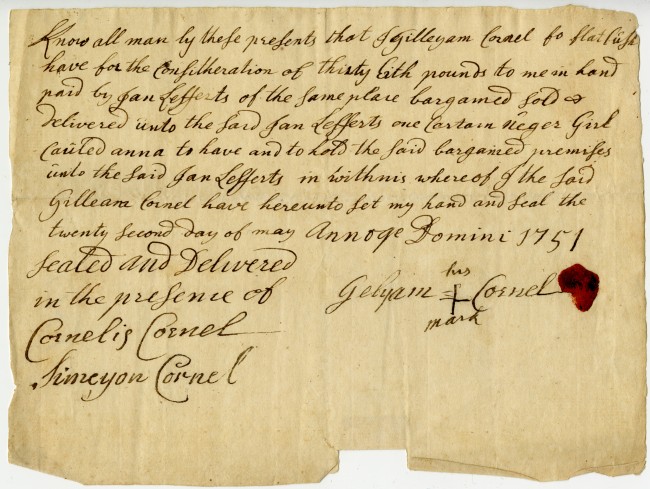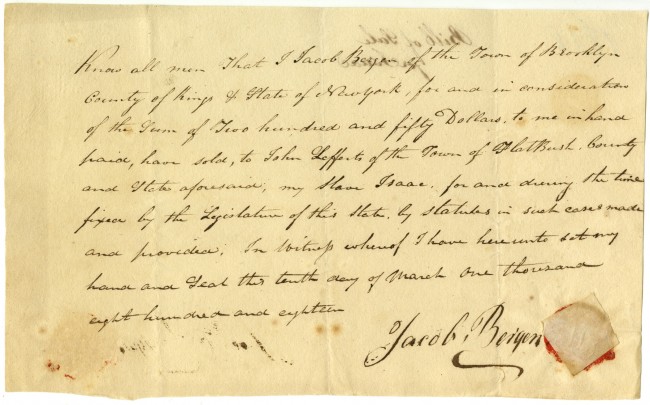“Know all men that I Jacob Bergen of the Town of Brooklyn County of Kings & State of New York, for and in consideration of the sum of Two hundred and fifty Dollars, to me in hand paid, have sold, to John Lefferts of the Town of Flatbush, County and State aforesaid, my Slave Isaac…”
– Bill of sale for Isaac, Jacob Bergen and John Lefferts, March 10, 1818
Slavery arrived in New Amsterdam and its environs with the first Dutch settlers. While some residents owned their own slaves, others used provided by the Dutch West India Company, a trading company that governed the colony until 1653. Residents of the small frontier town of Midwout relied on the labor of enslaved people to clear forests; to build houses, churches, town buildings, and roads; and to tend farms and hearths. The Lefferts family was no different. In the 1698 census, Leffert Pieterse, founder of the Lefferts family in America, reported that his household included three enslaved people.
As Kings County’s agricultural economy expanded during the eighteenth century, farmers and landowners like the Leffertses became even more reliant on enslaved labor. In 1698, 15% of Kings County residents were of African descent, and virtually all were enslaved. By 1738, that figure had risen to 25%. In 1790, that number rose again: African Americans accounted for over 30% of Kings County’s population; most were enslaved. In that same year, the population of the town of Flatbush included 378 enslaved people, 12 free black people, and 551 white people – 75% of whom were slaveholders.
As these numbers attest, even after the Revolutionary War, when notions of freedom and liberty permeated the American consciousness, Kings County remained a committed slave society. The area’s farmers relied on enslaved labor for their agricultural needs, even while slavery was on the decline in other parts of New York State.
Like virtually all wealthy families in Flatbush, the Leffertses owned significant numbers of slaves, and engaged in the trade, sale, and purchase of enslaved people up until emancipation was enacted in New York in 1827. Few sources exist on the personal details or experiences of Brooklyn’s enslaved population, especially before the American Revolution. But the dozens of bills of sale and indentures in the Lefferts family papers provide the names, ages, and other information about the enslaved men and women that helped build Brooklyn.
Learn More
When were enslaved Brooklynites emancipated?Slavery proved to be the great paradox of the American Revolution. As patriot leaders decried the “enslavement” of American colonists by the British, many continued to own enslaved Africans and African Americans themselves. Those who were not slaveholders rarely questioned the institution of slavery. Yet in the decades after the war, the ideas of the American Revolution gave rise to growing criticism of slavery, to a nascent abolitionist movement, and to the passage of emancipation laws in several northern states.
In part because regions like Kings County relied heavily on slave labor, New York was one of the last northern states to enact emancipation laws. In March 1799, the state legislature passed “An Act for the gradual abolition of slavery.” The law declared every child born of an enslaved person after July 4, 1799 to be free, but bound to serve the owner of his or her mother until he or she reached the age of twenty-five if female, and twenty-eight if male.
The bills of sale and indentures in the Lefferts family papers reflect this important change: when arranging for the exchange of African Americans born after 1799, many of the contracts signed by members of the Lefferts family indicated the date on which that servant would be free. These contracts often mandated that slaveholders provide said servants with a minimum amount of meat and clothing, teach them to read, and see to their religious upbringing – though these mandates were not necessarily upheld.
The 1799 law offered no rights to enslaved people born before July 4, 1799. This was not rectified until 1817, when the legislature declared that all enslaved people in New York State would be freed on July 4, 1827, regardless of their birth date. Nevertheless, slavery continued to persist in areas of Brooklyn even after emancipation. Some slaveholders argued that emancipation conflicted with the 1799 gradual manumission act, which promised them the service of the children of slaves born into their household until their mid-20s. In removed corners of rural Flatbush, many African Americans remained in servitude until the 1830s and early 1840s.
How did members of the Lefferts family remember “slavery days”?

Like Gertrude Lefferts Vanderbilt, the author of this Brooklyn Eagle article from the 1890s romanticized Brooklyn's slaveholding past.
By the late nineteenth century, members of many old Flatbush families, including the Leffertses, expressed a deep ambivalence about their ancestors’ slaveowning heritage. Gertrude Lefferts Vanderbilt, a historian who spent her life chronicling the history of Flatbush, Brooklyn, and the nation, wrote a number of articles on Kings County’s “slavery days.”
Throughout her writings, Gertrude attempted justify her ancestors’ status as slaveholders by insisting that Dutch slavery in colonial Brooklyn was mild and gentle, and that their practices bore little resemblance to those that existed on plantations in the antebellum South. “It is not probable that slavery ever exhibited its worst features on Long Island,” she insisted. “A kindly feeling existed between the owner and the slave.” Gertrude argued that the Dutch often consulted with their slaves when buying and selling them, and as a result, many enslaved people felt great loyalty and obedience towards Dutch slaveholders.
Other historical sources belie Gertrude’s assertion that Brooklyn’s enslaved people were “obedient” or that they accepted captivity cheerfully. Runaway slave advertisements and reports of acts of disobedience demonstrate ways that African American Brooklynites fought the bonds of slavery any way they could. Nor were Dutch slaveholders as benevolent and generous as she claimed. Many of the slave bills of sale in the Lefferts family papers chronicle the sale of small children without their mothers, bearing witness to the detrimental effects that slavery had on African American families.
Gertrude was the daughter of John Lefferts (1785-1829), himself a slaveowner, and she was born only three years before emancipation was enacted in New York. During her lifetime, she witnessed a nation transformed by growing conflict between slave and free states, by a violent Civil War, and by the controversial era of Reconstruction. Her assertions about colonial slavery are perhaps more reflective of the heated debates about slavery that served as the backdrop of her own life. Her writings also capture a paternalistic racism expressed by many white Americans during the nineteenth century.
New Amsterdam was one small fraction the DWIC’s international slave trading empire, however; most of the company’s business centered on the Caribbean.



